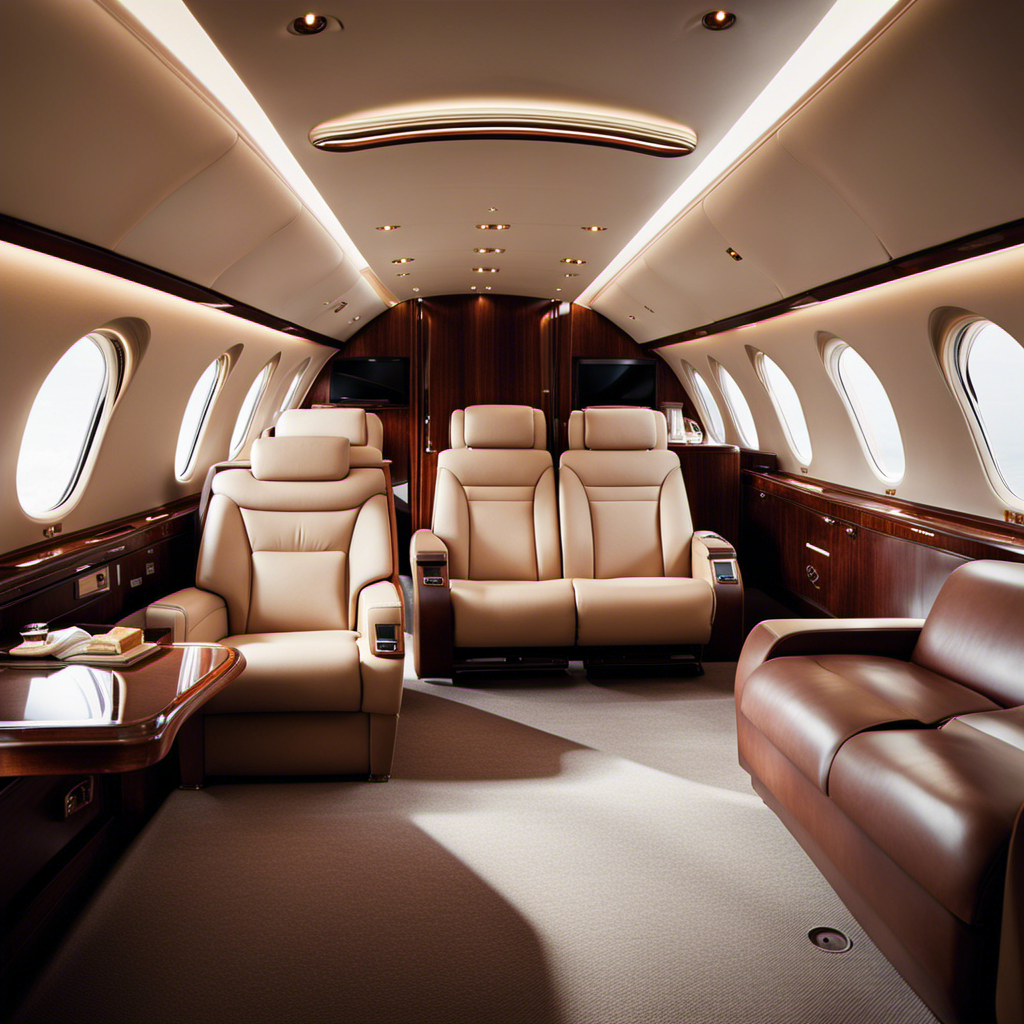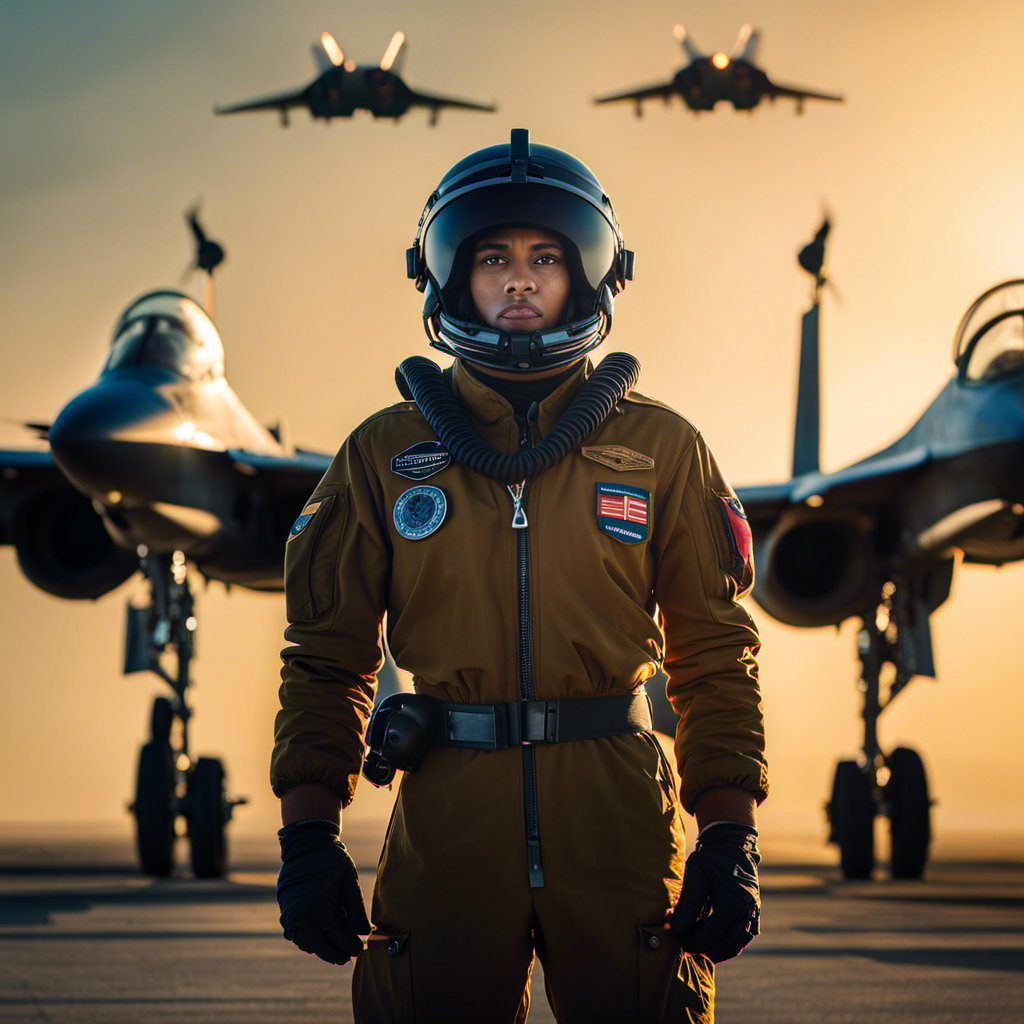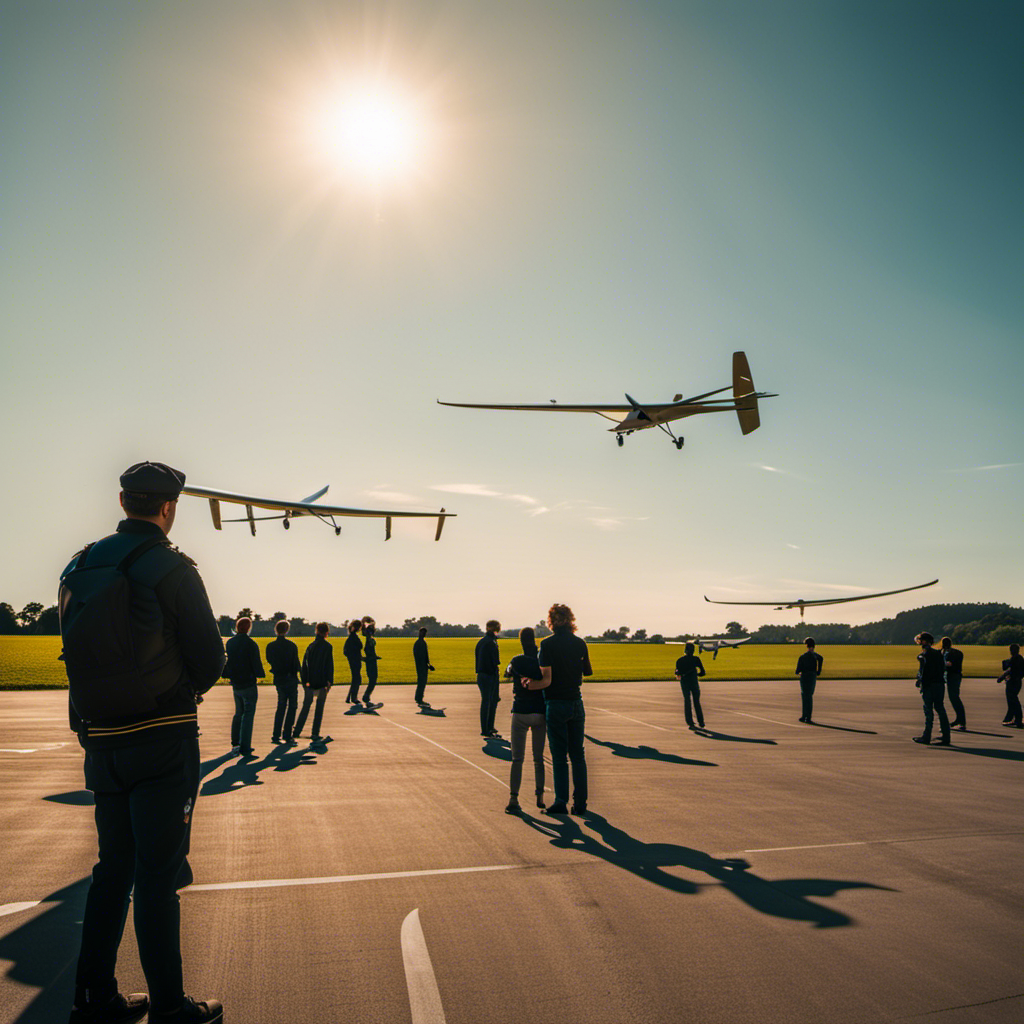Being a huge fan of aviation, my ultimate fantasy is to soar through the skies, relishing the freedom and luxury that comes with traveling in a private jet. If you want to learn more about the benefits of flying on a private jet, keep reading to discover why it’s such a thrilling experience!
In this article, I will take you on a thrilling journey as we delve into the world of private aviation. From learning the basics of flying to mastering advanced techniques, we will explore the ins and outs of piloting a private jet.
So fasten your seatbelts and get ready for a luxurious lift-off into the captivating realm of private jet aviation.
Key Takeaways
- Understanding the basics of flying a private jet and the importance of safety
- The process of flight training, certification, and pre-flight procedures
- Techniques for takeoff and landing, as well as advanced flying techniques
- Maximizing the private jet experience through customization and luxury amenities
Introduction to Private Aviation
If you want to experience the world of private aviation, you’ll need to understand the basics of flying a private jet.
Private jets offer a range of luxury amenities that cater to the needs and comfort of their passengers. From spacious cabins to plush seating, state-of-the-art entertainment systems, and gourmet catering, private jets provide an unparalleled level of luxury and exclusivity.
However, it’s important to consider the cost implications of flying a private jet. Owning and operating a private jet can be expensive, with costs including maintenance, fuel, insurance, and pilot fees. Additionally, there may be additional charges for landing fees and overnight stays at airports.
Understanding the cost considerations associated with private aviation is crucial for making informed decisions and maximizing the value of this luxurious experience.
Now, let’s delve into the details of understanding the basics of flying a private jet.
Understanding the Basics of Flying
To understand the basics of flying, you’ll need to familiarize yourself with the controls and instruments in the cockpit. Here are a few things you should know:
-
Controls:
-
The control column is used to control the pitch and roll of the aircraft. Pulling back on the column raises the nose, while pushing forward lowers it. Moving the column left or right controls the roll.
-
The rudder pedals control the yaw of the aircraft. Pressing the left pedal turns the aircraft left, while pressing the right pedal turns it right.
-
Instruments:
-
The airspeed indicator shows the aircraft’s speed in knots.
-
The altimeter displays the aircraft’s altitude above sea level.
-
The attitude indicator shows the aircraft’s pitch and roll.
When it comes to flying techniques, it’s important to remember to maintain a proper airspeed and altitude, and to make smooth and coordinated control inputs. Aviation safety is paramount, so always follow the pre-flight checklist and be aware of any potential hazards.
Now that you have an understanding of the basics, let’s move on to the next section on flight training and certification.
Flight Training and Certification
As I progress through flight training, obtaining the necessary certifications will be an important step in my journey to become a pilot.
One crucial aspect of flight training is utilizing flight simulation. Flight simulators provide a realistic environment where I can practice various flight maneuvers and emergency procedures. These simulations help me develop my skills and gain confidence before taking to the skies.
Additionally, having a knowledgeable and experienced flight instructor is essential during this process. A flight instructor will guide me through the necessary training, provide valuable insights, and ensure that I am meeting the required standards. With their guidance and expertise, I can learn to fly safely and effectively.
Now, let’s move on to the next section about pre-flight procedures, where attention to detail becomes paramount.
Pre-Flight Procedures
When it comes to pre-flight procedures, there are several key points that need to be addressed.
First and foremost, aircraft inspections and maintenance are crucial to ensure the safety and airworthiness of the aircraft. This includes checking for any signs of damage or malfunction, as well as performing routine maintenance tasks.
Additionally, fueling and weight and balance calculations are essential to ensure that the aircraft is properly fueled and balanced for the upcoming flight.
Lastly, effective communication with air traffic control is vital in order to receive necessary information and clearances for a successful and safe flight.
Aircraft Inspections and Maintenance
Make sure you’re aware of the necessary aircraft inspections and maintenance procedures to ensure your private jet is in optimal condition. Regular aircraft maintenance scheduling is essential to keep your aircraft in top shape. This involves adhering to a detailed aircraft inspection checklist, which covers all the crucial areas of the aircraft, including the engines, avionics systems, and structural components.
Here are three key points to consider:
-
Regular Inspections: Schedule routine inspections to identify and address any potential issues before they become major problems.
-
Preventive Maintenance: Implement a proactive maintenance plan to prevent unexpected breakdowns and ensure the longevity of your aircraft.
-
Compliance with Regulations: Stay up to date with the latest regulations and guidelines to ensure your aircraft meets all safety standards.
By following these aircraft inspection and maintenance procedures, you can ensure the safety and reliability of your private jet.
Now let’s move on to fueling and weight and balance calculations, which are vital for a successful flight.
Fueling and Weight and Balance Calculations
Fueling and weight and balance calculations are crucial aspects of preparing for a successful flight. Ensuring fuel efficiency and maintaining proper weight distribution are essential for a safe and efficient journey.
When fueling the aircraft, it is important to consider factors such as the distance of the flight, anticipated weather conditions, and any potential diversions. This helps determine the amount of fuel needed, optimizing fuel efficiency while ensuring a sufficient reserve.
Additionally, weight and balance calculations are vital to maintain the aircraft’s stability and performance. By considering the weight of passengers, baggage, and cargo, as well as their distribution throughout the aircraft, pilots can ensure a balanced load and avoid potential handling issues.
Proper fueling and weight and balance calculations are essential for a smooth takeoff and flight.
Now, let’s delve into the next crucial aspect of flying – communication with air traffic control.
Communication with Air Traffic Control
To ensure a smooth and safe flight, it’s important to communicate effectively with air traffic control. Air traffic control procedures and radio communication techniques play a vital role in aviation.
When communicating with air traffic control, use clear and concise language to convey your intentions and receive instructions. Follow established procedures for initiating and maintaining contact with air traffic control. This includes stating your aircraft call sign, position, altitude, and intentions.
Effective radio communication ensures that pilots are aware of other aircraft in their vicinity and can safely navigate through congested airspace. By following air traffic control procedures and utilizing effective radio communication techniques, pilots can ensure a seamless and organized flow of air traffic.
Now, let’s transition into the subsequent section about takeoff and landing techniques.
Takeoff and Landing Techniques
Flying a private jet requires mastering takeoff and landing techniques. These crucial skills ensure a safe and smooth journey for both passengers and crew. Here are four important aspects to consider when it comes to takeoff and landing:
-
Takeoff speed: Knowing the precise speed at which to lift off is essential. This is determined by factors such as aircraft weight, runway length, and weather conditions. Striking the right balance ensures a successful takeoff.
-
Landing gear: Understanding the intricacies of the landing gear is vital for a pilot. It involves knowing when to deploy and retract it, as well as monitoring its functionality throughout the flight. This system plays a critical role in ensuring a safe landing.
-
Approach and touchdown: A pilot must have a solid understanding of the correct approach angles and glide paths to execute a smooth touchdown. This involves maintaining precise speed, altitude, and alignment with the runway.
-
Emergency procedures: Being prepared for unforeseen circumstances is crucial. Pilots must be trained in emergency landing procedures in case of engine failure or other critical situations.
Mastering these takeoff and landing techniques sets the foundation for a successful flight.
As we transition into the subsequent section on in-flight navigation and communication, it’s important to maintain a thorough understanding of the aircraft’s handling capabilities.
In-Flight Navigation and Communication
As you navigate through the skies in your private jet, it’s important to have a clear understanding of in-flight navigation and communication systems. These systems not only ensure a smooth and efficient flight, but also contribute to passenger comfort and safety.
In-flight navigation involves using advanced technology such as GPS, flight management systems, and autopilot to determine the aircraft’s position, plan routes, and avoid obstacles. These tools help pilots navigate through the airspace with precision and accuracy, ensuring that the aircraft stays on track and reaches its destination safely.
Communication systems, on the other hand, facilitate effective communication between the pilot and air traffic control, as well as provide in-flight entertainment for passengers. Clear and reliable communication is crucial for pilots to receive important instructions and updates from air traffic control, ensuring that the flight operates smoothly and safely. Additionally, in-flight entertainment systems keep passengers entertained and engaged during the flight, enhancing their overall experience.
Speaking of passenger comfort, private jets often come equipped with state-of-the-art entertainment systems, luxurious seating, and spacious cabins. These amenities aim to make the flying experience enjoyable and relaxing for passengers. Whether it’s watching movies, listening to music, or simply reclining in comfortable seats, these features contribute to a pleasant journey.
With a firm grasp of these systems, you’re ready to move on to managing flight risks and safety seamlessly. By understanding and utilizing the navigation and communication systems effectively, pilots can ensure a safe and enjoyable flight experience for everyone on board.
Managing Flight Risks and Safety
When it comes to managing flight risks and safety, there are three key points that need to be addressed.
First, identifying and mitigating potential hazards involves conducting thorough risk assessments before each flight. This includes identifying any potential threats and implementing appropriate measures to minimize those risks.
Second, emergency preparedness and response is crucial. It entails having a well-defined plan in place for various emergency situations, such as engine failures or severe weather conditions. It is essential to ensure that all crew members are trained and equipped to handle such scenarios.
Lastly, maintaining situational awareness is crucial for pilots. They need to stay informed about their surroundings, including weather conditions, air traffic, and potential obstacles. This allows them to make informed decisions and prevent accidents.
Overall, addressing these three points is essential for effective flight risk management and safety.
Identifying and Mitigating Potential Hazards
To identify and mitigate potential hazards, you’ll need to thoroughly assess the condition of the private jet before takeoff. This step is crucial in ensuring a safe and smooth flight. By conducting a comprehensive inspection, you can identify any potential risks and take appropriate actions to mitigate them. Here are some key areas to focus on during the assessment:
| Potential Hazards | Hazard Mitigation Strategies |
|---|---|
| Fuel leaks | Regular inspection and maintenance of fuel system |
| Electrical malfunctions | Check wiring and connections for any signs of damage |
| Engine failure | Regular servicing and monitoring engine performance |
| Weather conditions | Constantly monitor weather forecasts and plan accordingly |
| Runway conditions | Assess runway surface for any potential hazards |
Emergency Preparedness and Response
Make sure you’re equipped with the necessary knowledge and skills to handle any emergency situations that may arise during your flight.
Emergency response planning and communication protocols play a crucial role in ensuring the safety of everyone on board. Familiarize yourself with the emergency response plan specific to your aircraft, including evacuation procedures, fire suppression systems, and emergency exits.
Additionally, understand how to communicate with air traffic control and emergency services in case of an emergency. Establishing clear communication protocols and practicing emergency scenarios can greatly enhance response effectiveness.
Maintaining situational awareness is another vital aspect of emergency preparedness. Being aware of your surroundings, monitoring instruments, and staying informed about weather conditions will help you anticipate potential emergencies and respond accordingly.
Maintaining Situational Awareness
Maintaining situational awareness is crucial for anticipating and responding to potential emergencies during a flight. As a pilot, I rely on a set of techniques to ensure that I am fully aware of my surroundings at all times. Here are four key strategies I use to enhance my situational awareness:
-
Continuous scanning: I constantly scan the horizon, monitoring for any changes in weather, other aircraft, or potential obstacles.
-
Effective communication: Clear and concise communication with air traffic control and other pilots helps me stay informed about the current airspace situation.
-
Instrument interpretation: By carefully monitoring my instruments, I can gather critical information about altitude, speed, and heading, enabling me to make informed decisions.
-
Mental mapping: I create a mental map of my flight path and constantly update it, keeping track of key landmarks and navigation points.
Maintaining situational awareness is of utmost importance as it allows me to detect and respond to potential threats or emergencies promptly. By staying aware of my surroundings, I can ensure the safety and success of my flight.
As we transition into the next section on advanced flying techniques, let’s explore how these skills can be further honed and applied in more complex scenarios.
Advanced Flying Techniques
When it comes to advanced flying techniques, there are three key areas that pilots need to master: instrument flying and navigation, night flying and cross-country flights, and aerobatics and advanced maneuvers.
Instrument flying and navigation involve using the aircraft’s instruments to navigate and maintain control in poor visibility conditions, such as clouds or fog.
Night flying and cross-country flights require additional skills and planning to safely navigate and maintain situational awareness during nighttime operations and long-distance flights.
Instrument Flying and Navigation
Flying a private jet requires proficiency in instrument flying and navigation techniques. Instrument flying involves using aircraft instruments to navigate and maintain control of the aircraft, especially during low visibility conditions. Navigation techniques include chart reading, radio navigation, and GPS usage.
Accurate instrument calibration is crucial for reliable readings, ensuring the safety of the flight. Weather forecasting plays a vital role in instrument flying, as it helps anticipate and plan for weather-related challenges. By analyzing weather patterns and forecasts, pilots can make informed decisions regarding route planning and potential diversions.
As a pilot, it is essential to continually update knowledge and skills in instrument flying and navigation to ensure the smooth operation of private jet flights. This proficiency is particularly important when undertaking night flying and cross-country flights, which require additional considerations and planning.
Night Flying and Cross-Country Flights
After mastering instrument flying and navigation, the next phase of my training was focused on night flying and planning cross-country flights.
Night flying safety became a crucial aspect of my training as it presented a unique set of challenges. I learned about the importance of proper lighting on the aircraft, using visual aids such as runway lights, and maintaining situational awareness in the dark.
Additionally, I was taught how to plan cross-country routes, taking into account factors such as weather conditions, terrain, and airspace restrictions. I became proficient in using navigation charts and instruments to plot my course and calculate fuel requirements. These skills were essential for long-distance flights, where precision and careful planning were vital.
Now, having mastered night flying and cross-country flights, I was ready to move on to the exhilarating world of aerobatics and advanced maneuvers.
Aerobatics and Advanced Maneuvers
To master advanced maneuvers and aerobatics, you’ll need to develop precise control over the aircraft and execute maneuvers with confidence.
In the world of aviation, aerobatics refers to the art of performing extraordinary maneuvers in the sky. It is a thrilling and visually impressive display of skill and precision. Many pilots participate in aerobatic competitions, where they showcase their abilities and compete against others. Additionally, some pilots perform aerobatics in airshow performances, entertaining audiences with their daring maneuvers and breathtaking stunts.
These advanced maneuvers require a deep understanding of the aircraft’s capabilities and limitations, as well as the ability to maintain situational awareness at all times. By mastering aerobatics, pilots enhance their flying skills and gain a greater appreciation for the intricacies of flight.
Understanding aircraft systems is crucial for safe and efficient operation.
Understanding Aircraft Systems
When you’re familiar with the aircraft systems, you’ll be able to confidently navigate your private jet. Understanding the various components and functions of the cockpit instruments is essential for safe and efficient flying. Let’s take a closer look at some of the key systems and instruments:
| Systems | Instruments |
|---|---|
| Electrical | Altimeter |
| Fuel | Airspeed Indicator |
| Hydraulic | Attitude Indicator |
| Navigation | Vertical Speed Indicator |
| Communication | Heading Indicator |
| Environmental Control | Turn Coordinator |
These systems and instruments play a crucial role in aircraft maintenance and ensuring a smooth flight experience. The electrical system powers the instruments, while the fuel system supplies the necessary fuel for the engines. The hydraulic system controls the movement of various aircraft parts, and the navigation and communication systems enable effective navigation and communication with air traffic control. Lastly, the environmental control system regulates temperature and pressurization within the aircraft cabin.
Understanding these systems and instruments not only ensures the safety of your flight but also allows you to make informed decisions during your journey. Now that we’ve covered the technical aspects, let’s delve into the joy of flying private without missing any details.
The Joy of Flying Private
Imagine yourself reclining in a plush leather seat, sipping on a refreshing beverage, and enjoying the breathtaking views from your own private aircraft. Flying in a private jet offers a multitude of benefits, including the unparalleled privacy it provides.
With no strangers around, you can relax and unwind in complete seclusion. The personalized experience is another remarkable aspect of flying private. From the moment you step on board, the crew caters to your every need, ensuring your comfort and satisfaction.
Whether it’s customizing the in-flight menu to your preferences or adjusting the cabin temperature to your liking, every detail is tailored to your desires. This level of attention and exclusivity elevates the flying experience to a whole new level.
Frequently Asked Questions
What are the advantages of flying a private jet compared to commercial airlines?
Flying a private jet offers numerous advantages compared to commercial airlines. With luxurious travel experience, I enjoy personalized service, privacy, and comfort. Additionally, private jets provide flexibility in scheduling and direct access to smaller airports, saving time and hassle.
Are there any specific requirements or qualifications needed to fly a private jet?
To fly a private jet, you need a pilot license and flight experience. Obtaining a pilot license involves meeting specific training requirements and passing exams. Flight experience is gained through hours of flying and practical training.
How much does it cost to own and operate a private jet?
Owning and operating a private jet can be a costly endeavor. For example, a midsize jet can cost around $10 million to purchase, and annual maintenance expenses can range from $500,000 to $2 million.
Can a private jet be rented for a one-time trip, or do you need to own one to fly it?
You can rent a private jet for a one-time trip without needing to own one. Renting a private jet is a convenient and flexible option, allowing you to experience the luxury of flying privately without the commitment of ownership.
Are there any limitations or restrictions on where you can fly with a private jet?
There are limitations and restrictions on where I can fly with a private jet. Airspace regulations, airport restrictions, and customs requirements all play a role in determining my flight path and destinations.
Conclusion
In conclusion, learning to fly a private jet has been an exhilarating journey. From understanding the basics of flying to mastering advanced techniques, the joy of taking control of your own flight is truly unmatched.
As I soar through the skies, I can’t help but marvel at the beauty and freedom that comes with private aviation. It’s a luxury lift-off that allows me to escape the mundane and embrace the extraordinary.
So, if you ever get the chance, don’t hesitate to spread your wings and experience the wonders of flying private.









